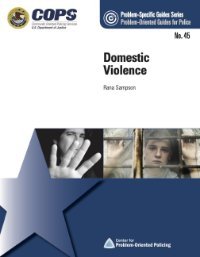This guide begins by describing the problem of domestic violence and reviewing factors that increase its risks.† It then identifies a series of questions to help you analyze your local domestic violence problem. Finally, it reviews responses to the problem and what is known about these from evaluative research and police practice. Domestic disputes are some of the most common calls for police service. Many domestic disputes do not involve violence; this guide discusses those that do, as well as the measures that can be used to reduce them.
The guide begins by describing the problem and reviewing factors that increase the risks of Internet child pornography. It then identifies a series of questions that might assist you in analyzing your local Internet child pornography problem. Finally, it reviews responses to the problem and what is known about these from evaluative research and police practice.
By Graeme R. Newman and James Corey
This guide begins by describing the problem of exploiting women who have been trafficked into the United States, and the aspects of human trafficking that contribute to it. Throughout the guide, the word “trafficked” shall mean internationally trafficked, unless otherwise stated. Additionally, the guide’s focus is on the final period in the process of trafficking at which women are further exploited by those into whose hands they are passed. This is the point at which human trafficking becomes a problem for local police and so the guide identifies a series of questions that can help analyze local problems related to trafficking. Finally, it reviews responses to the exploitation of trafficked women and examines what is known about the effectiveness of these responses from research and police practice.
Concern about the exploitation of women who have been trafficked into the United States derives from the international issues of human trafficking and slavery.† The characteristics of international human trafficking, including the profits, resemble those of the international drug trade.[1] In the United States, until the passage of the Trafficking Victims Protection Act (TVPA) in 2000, human trafficking was approached as an immigration problem, which meant that police viewed trafficking as a federal rather than a local responsibility. The protections established by the TVPA have been strengthened and reauthorized every five years starting in 2005. The most recent reauthorization occurred in 2017. The information in this guide reflects the most current information. The TVPA clarified the definition of human trafficking—a particularly difficult problem, as will be seen below—and introduced a number of important protections for trafficked individuals (see BOX 1). The TVPA defines two forms of severe human trafficking:
Read more at the Center for Problem Oriented Policing
This guide describes the problem of acquaintance rape of college students, addressing its scope, causes and contributing factors; methods for analyzing it on a particular campus; tested responses; and measures for assessing response effectiveness. With this information, police and campus public-safety officers can more effectively reduce the problem.
Read more at the Center for Problem Oriented Policing





